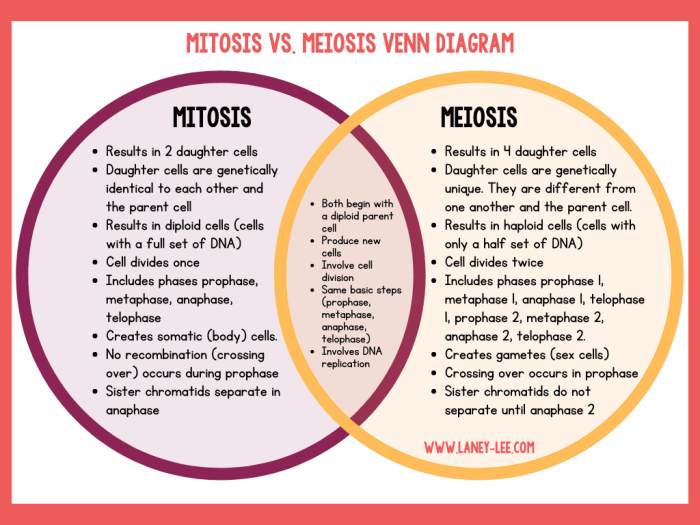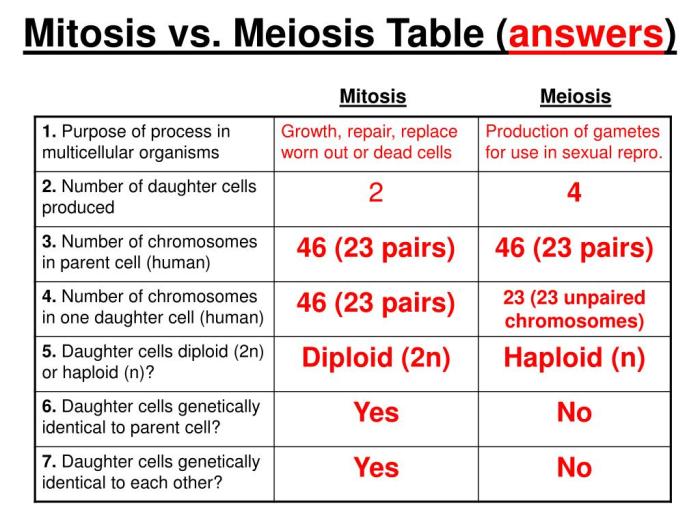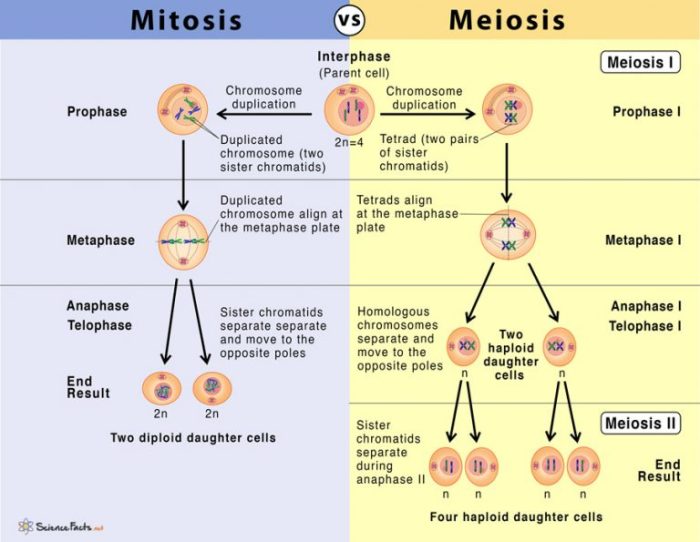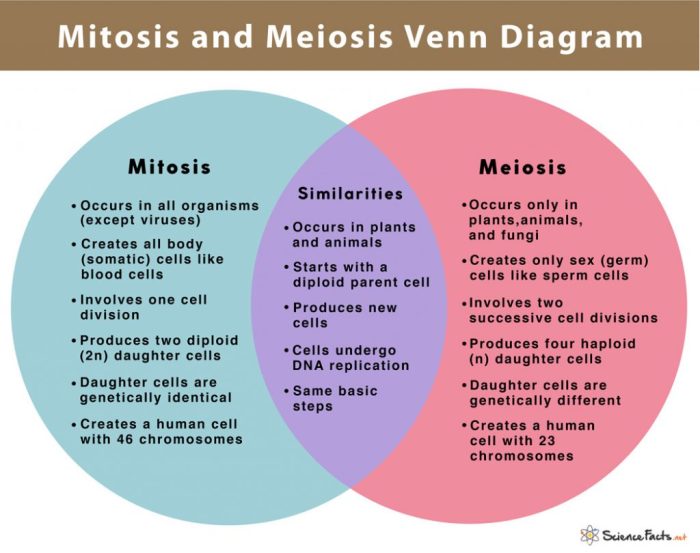Embark on a scientific journey with our mitosis vs meiosis chart answer key, an authoritative guide that unravels the complexities of cellular division. Discover the fundamental differences and similarities between mitosis and meiosis, deciphering their distinct roles in growth, repair, and reproduction.
Through meticulously crafted explanations and a comprehensive table, this resource provides a clear understanding of the stages, key events, and genetic implications of both processes. Delve into the intricacies of chromosome behavior, genetic material distribution, and the intricate regulatory mechanisms that govern mitosis and meiosis.
Mitosis vs. Meiosis
Mitosis and meiosis are two distinct cell division processes that occur in eukaryotic organisms. Mitosis is a process of cell division that results in two identical daughter cells, while meiosis is a process of cell division that results in four daughter cells, each with half the number of chromosomes as the parent cell.
Basic Concepts
Mitosisis a continuous process that can be divided into four distinct stages: prophase, metaphase, anaphase, and telophase. During prophase, the chromosomes become visible and the nuclear envelope begins to break down. In metaphase, the chromosomes line up in the center of the cell.
In anaphase, the chromosomes are separated and pulled to opposite poles of the cell. In telophase, two new nuclear envelopes form around the chromosomes and the cell membrane pinches in the middle, dividing the cell into two identical daughter cells.
Meiosisis a more complex process than mitosis and consists of two rounds of cell division, known as meiosis I and meiosis II. During meiosis I, the chromosomes are paired up and then separated, resulting in two daughter cells with half the number of chromosomes as the parent cell.
During meiosis II, the daughter cells from meiosis I undergo another round of cell division, resulting in four daughter cells, each with half the number of chromosomes as the parent cell.
Key Differences
- Mitosis produces two identical daughter cells, while meiosis produces four daughter cells, each with half the number of chromosomes as the parent cell.
- Mitosis occurs in somatic cells, while meiosis occurs in germ cells.
- Mitosis is a continuous process, while meiosis consists of two rounds of cell division.
Similarities
- Both mitosis and meiosis are processes of cell division.
- Both mitosis and meiosis involve the separation of chromosomes.
- Both mitosis and meiosis are essential for the growth and development of organisms.
Stages of Mitosis and Meiosis

Mitosis and meiosis are two distinct cell division processes that occur in eukaryotic cells. Mitosis results in two genetically identical daughter cells, while meiosis produces four genetically diverse daughter cells.
Both mitosis and meiosis consist of several stages, each with specific key events. The following table summarizes the stages and key events of mitosis and meiosis:
Table: Stages of Mitosis and Meiosis
| Mitosis Stages | Meiosis I Stages | Meiosis II Stages | Key Events |
|---|---|---|---|
| Interphase | Interphase I | Interphase II | Cell growth, DNA replication |
| Prophase | Prophase I | Prophase II | Chromosome condensation, nuclear envelope breakdown |
| Metaphase | Metaphase I | Metaphase II | Chromosomes align at the equator of the cell |
| Anaphase | Anaphase I | Anaphase II | Chromosomes separate and move to opposite poles of the cell |
| Telophase | Telophase I | Telophase II | Nuclear envelopes reform, chromosomes decondense |
| Cytokinesis | Cytokinesis I | Cytokinesis II | Division of the cytoplasm, resulting in two (mitosis) or four (meiosis) daughter cells |
Chromosomes and Genetic Material

Role of Chromosomes in Mitosis and Meiosis
Chromosomes play a crucial role in both mitosis and meiosis, ensuring the accurate distribution of genetic material to daughter cells. During mitosis, chromosomes are duplicated and then separated into two identical sets, which are then distributed to the two daughter cells.
This process ensures that each daughter cell receives a complete set of genetic information.In meiosis, chromosomes undergo a more complex process of recombination and segregation. During this process, homologous chromosomes pair up and exchange genetic material, resulting in the creation of new chromosome combinations.
The chromosomes are then separated into four haploid sets, each of which is distributed to a different daughter cell. This process ensures that each daughter cell receives a unique combination of genetic material.
Behavior of Chromosomes during Mitosis and Meiosis
*Mitosis
1. Prophase
Chromosomes become visible and condense. The nuclear envelope breaks down.
2. Metaphase
Chromosomes align at the equator of the cell.
3. Anaphase
Sister chromatids separate and move to opposite poles of the cell.
4. Telophase
Chromosomes reach the poles of the cell and the nuclear envelope reforms.Meiosis
1. Prophase I
Homologous chromosomes pair up and exchange genetic material.
2. Metaphase I
Homologous chromosomes align at the equator of the cell.
3. Anaphase I
Homologous chromosomes separate and move to opposite poles of the cell.
4. Telophase I
Chromosomes reach the poles of the cell and the nuclear envelope reforms.
5. Prophase II
Chromosomes condense again.
6. Metaphase II
Chromosomes align at the equator of the cell.
7. Anaphase II
Sister chromatids separate and move to opposite poles of the cell.
8. Telophase II
Chromosomes reach the poles of the cell and the nuclear envelope reforms.
Differences in Genetic Material Distribution between Mitosis and Meiosis
- *Mitosis
- Results in two daughter cells that are genetically identical to the parent cell.
- Maintains the diploid number of chromosomes (2n).
- Occurs in somatic cells (non-reproductive cells).
Meiosis
- Results in four daughter cells that are genetically different from the parent cell.
- Reduces the diploid number of chromosomes to the haploid number (n).
- Occurs in reproductive cells (gametes).
Purposes and Outcomes of Mitosis and Meiosis

Mitosis and meiosis are two distinct cell division processes that play vital roles in the life cycle of eukaryotic organisms. Each process has a specific purpose and leads to different outcomes in terms of chromosome number and genetic variation.
Purpose of Mitosis
Mitosis is the process by which a cell divides into two identical daughter cells. It is responsible for cell growth, repair, and asexual reproduction. During mitosis, the cell’s chromosomes are replicated and then separated into two sets, one for each daughter cell.
This ensures that each daughter cell receives the same genetic material as the parent cell.
Purpose of Meiosis
Meiosis is the process by which a cell divides into four haploid daughter cells. It is responsible for sexual reproduction. During meiosis, the cell’s chromosomes are replicated and then undergo two rounds of division, resulting in four daughter cells with half the number of chromosomes as the parent cell.
This process also involves genetic recombination, which shuffles the genetic material and creates new combinations of alleles. This genetic variation is essential for evolution and adaptation.
Comparison of Outcomes
The table below summarizes the key differences between mitosis and meiosis in terms of chromosome number and genetic variation:
| Process | Chromosome Number | Genetic Variation |
|---|---|---|
| Mitosis | Diploid (2n) | None |
| Meiosis | Haploid (n) | High |
Regulation and Control of Mitosis and Meiosis
Mitosis and meiosis are highly regulated processes that ensure the accurate distribution of genetic material to daughter cells. The initiation and progression of these processes are tightly controlled by a complex network of regulatory factors.
Regulation of Mitosis
- Cyclin-dependent kinases (CDKs):CDKs are a family of enzymes that regulate the cell cycle. They are activated by cyclins, which are proteins that accumulate and degrade in a cell cycle-dependent manner. CDKs phosphorylate various target proteins, including nuclear envelope proteins, histones, and mitotic spindle proteins, to promote the progression of mitosis.
- Mitotic checkpoints:Mitotic checkpoints are surveillance mechanisms that ensure the accuracy of mitosis. The most important checkpoints are the G2/M checkpoint, which prevents cells from entering mitosis if DNA is damaged, and the spindle assembly checkpoint, which prevents anaphase from occurring if all chromosomes are not properly attached to the mitotic spindle.
Regulation of Meiosis
- Meiotic checkpoints:Meiotic checkpoints are similar to mitotic checkpoints, but they are specific to meiosis. The most important meiotic checkpoints are the pachytene checkpoint, which prevents cells from progressing beyond prophase I if homologous chromosomes have not properly paired, and the metaphase I checkpoint, which prevents cells from entering anaphase I if all chromosomes are not properly attached to the meiotic spindle.
- Recombination nodules:Recombination nodules are protein complexes that form at sites of genetic recombination during meiosis. They help to align homologous chromosomes and promote the exchange of genetic material.
Errors in Mitosis and Meiosis: Mitosis Vs Meiosis Chart Answer Key

Errors in mitosis and meiosis can lead to serious consequences for cell function and organismal health. These errors can result in the formation of abnormal cells, which may not be able to function properly or may even be harmful to the organism.
Consequences of Errors in Mitosis and Meiosis
- Aneuploidy:Aneuploidy is a condition in which a cell has an abnormal number of chromosomes. This can occur when errors occur during mitosis or meiosis, resulting in the formation of cells with too many or too few chromosomes. Aneuploidy can lead to a variety of health problems, including developmental disabilities, mental retardation, and cancer.
- Polyploidy:Polyploidy is a condition in which a cell has more than two complete sets of chromosomes. This can occur when errors occur during mitosis or meiosis, resulting in the formation of cells with three or more complete sets of chromosomes.
Polyploidy can lead to a variety of health problems, including developmental disabilities, mental retardation, and cancer.
- Mosaicism:Mosaicism is a condition in which an individual has two or more populations of cells with different genetic makeups. This can occur when errors occur during mitosis or meiosis, resulting in the formation of cells with different numbers or types of chromosomes.
Mosaicism can lead to a variety of health problems, including developmental disabilities, mental retardation, and cancer.
Mechanisms to Prevent or Correct Errors in Mitosis and Meiosis, Mitosis vs meiosis chart answer key
There are a number of mechanisms that help to prevent or correct errors in mitosis and meiosis. These mechanisms include:
- Checkpoints:Checkpoints are points in the cell cycle where the cell checks for errors. If an error is detected, the cell can stop the cell cycle and repair the error before it can cause any harm.
- DNA repair mechanisms:DNA repair mechanisms are processes that can repair damaged DNA. These mechanisms can help to prevent errors in mitosis and meiosis by repairing any damage that occurs to the DNA.
- Apoptosis:Apoptosis is a process of programmed cell death. Cells that are damaged or have errors in their DNA can undergo apoptosis to prevent them from causing any harm to the organism.
Clarifying Questions
What is the primary function of mitosis?
Mitosis facilitates cell growth, tissue repair, and asexual reproduction by generating genetically identical daughter cells.
How does meiosis differ from mitosis in terms of chromosome number?
Meiosis reduces the chromosome number by half, resulting in daughter cells with haploid sets of chromosomes, while mitosis maintains the diploid chromosome number.
What is the significance of genetic recombination during meiosis?
Genetic recombination in meiosis shuffles genetic material, leading to increased genetic diversity and the generation of unique offspring.